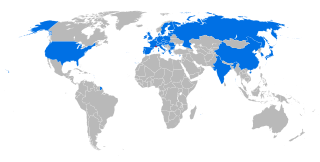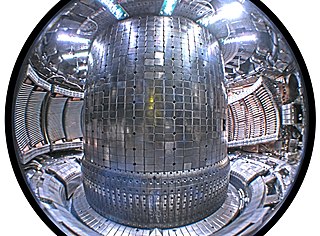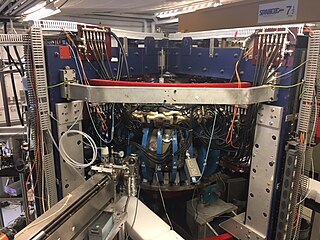
Deuterium is one of two stable isotopes of hydrogen. The nucleus of a deuterium atom, called a deuteron, contains one proton and one neutron, whereas the far more common protium has no neutrons in the nucleus. Deuterium has a natural abundance in Earth's oceans of about one atom of deuterium among every 6,420 atoms of hydrogen. Thus deuterium accounts for approximately 0.0156% by number of all the naturally occurring hydrogen in the oceans, while protium accounts for more than 99.98%. The abundance of deuterium changes slightly from one kind of natural water to another.

Heavy water is a form of water whose hydrogen atoms are all deuterium rather than the common hydrogen-1 isotope that makes up most of the hydrogen in normal water. The presence of the heavier hydrogen isotope gives the water different nuclear properties, and the increase in mass gives it slightly different physical and chemical properties when compared to normal water.
Helium-3 is a light, stable isotope of helium with two protons and one neutron. Other than protium, helium-3 is the only stable isotope of any element with more protons than neutrons. Helium-3 was discovered in 1939.

Tritium or hydrogen-3 is a rare and radioactive isotope of hydrogen with a half-life of about 12 years. The nucleus of tritium contains one proton and two neutrons, whereas the nucleus of the common isotope hydrogen-1 (protium) contains one proton and zero neutrons, and that of hydrogen-2 (deuterium) contains one proton and one neutron.

Fusion power is a proposed form of power generation that would generate electricity by using heat from nuclear fusion reactions. In a fusion process, two lighter atomic nuclei combine to form a heavier nucleus, while releasing energy. Devices designed to harness this energy are known as fusion reactors. Research into fusion reactors began in the 1940s, but as of 2023, no device has reached net power.

ITER is an international nuclear fusion research and engineering megaproject aimed at creating energy through a fusion process similar to that of the Sun. Upon completion of construction of the main reactor and first plasma, planned for late 2025, it will be the world's largest magnetic confinement plasma physics experiment and the largest experimental tokamak nuclear fusion reactor. It is being built next to the Cadarache facility in southern France. ITER will be the largest of more than 100 fusion reactors built since the 1950s, with ten times the plasma volume of any other tokamak operating today.

Neutron generators are neutron source devices which contain compact linear particle accelerators and that produce neutrons by fusing isotopes of hydrogen together. The fusion reactions take place in these devices by accelerating either deuterium, tritium, or a mixture of these two isotopes into a metal hydride target which also contains deuterium, tritium or a mixture of these isotopes. Fusion of deuterium atoms results in the formation of a helium-3 ion and a neutron with a kinetic energy of approximately 2.5 MeV. Fusion of a deuterium and a tritium atom results in the formation of a helium-4 ion and a neutron with a kinetic energy of approximately 14.1 MeV. Neutron generators have applications in medicine, security, and materials analysis.

Aneutronic fusion is any form of fusion power in which very little of the energy released is carried by neutrons. While the lowest-threshold nuclear fusion reactions release up to 80% of their energy in the form of neutrons, aneutronic reactions release energy in the form of charged particles, typically protons or alpha particles. Successful aneutronic fusion would greatly reduce problems associated with neutron radiation such as damaging ionizing radiation, neutron activation, reactor maintenance, and requirements for biological shielding, remote handling and safety.

Neutron activation is the process in which neutron radiation induces radioactivity in materials, and occurs when atomic nuclei capture free neutrons, becoming heavier and entering excited states. The excited nucleus decays immediately by emitting gamma rays, or particles such as beta particles, alpha particles, fission products, and neutrons. Thus, the process of neutron capture, even after any intermediate decay, often results in the formation of an unstable activation product. Such radioactive nuclei can exhibit half-lives ranging from small fractions of a second to many years.

Hydrogen (1H) has three naturally occurring isotopes, sometimes denoted 1
H
, 2
H
, and 3
H
. 1
H
and 2
H
are stable, while 3
H
has a half-life of 12.32(2) years. Heavier isotopes also exist, all of which are synthetic and have a half-life of less than one zeptosecond (10−21 s). Of these, 5
H
is the least stable, while 7
H
is the most.

DEMO refers to a proposed class of nuclear fusion experimental reactors that are intended to demonstrate the net production of electric power from nuclear fusion. Most of the ITER partners have plans for their own DEMO-class reactors. With the possible exception of the EU and Japan, there are no plans for international collaboration as there was with ITER.

The International Fusion Materials Irradiation Facility, also known as IFMIF, is a projected material testing facility in which candidate materials for the use in an energy producing fusion reactor can be fully qualified. IFMIF will be an accelerator-driven neutron source producing a high intensity fast neutron flux with a spectrum similar to that expected at the first wall of a fusion reactor using a deuterium-lithium nuclear reaction. The IFMIF project was started in 1994 as an international scientific research program, carried out by Japan, the European Union, the United States, and Russia, and managed by the International Energy Agency. Since 2007, it has been pursued by Japan and the European Union under the Broader Approach Agreement in the field of fusion energy research, through the IFMIF/EVEDA project, which conducts engineering validation and engineering design activities for IFMIF. The construction of IFMIF is recommended in the European Roadmap for Research Infrastructures Report, which was published by the European Strategy Forum on Research Infrastructures (ESFRI).
Magnetized Target Fusion (MTF) is a fusion power concept that combines features of magnetic confinement fusion (MCF) and inertial confinement fusion (ICF). Like the magnetic approach, the fusion fuel is confined at lower density by magnetic fields while it is heated into a plasma. As with the inertial approach, fusion is initiated by rapidly squeezing the target to greatly increase fuel density and temperature. Although the resulting density is far lower than in ICF, it is thought that the combination of longer confinement times and better heat retention will let MTF operate, yet be easier to build. The term magneto-inertial fusion (MIF) is similar, but encompasses a wider variety of arrangements. The two terms are often applied interchangeably to experiments.

The liquid fluoride thorium reactor is a type of molten salt reactor. LFTRs use the thorium fuel cycle with a fluoride-based molten (liquid) salt for fuel. In a typical design, the liquid is pumped between a critical core and an external heat exchanger where the heat is transferred to a nonradioactive secondary salt. The secondary salt then transfers its heat to a steam turbine or closed-cycle gas turbine.
Hybrid nuclear fusion–fission is a proposed means of generating power by use of a combination of nuclear fusion and fission processes.
A pressurized heavy-water reactor (PHWR) is a nuclear reactor that uses heavy water (deuterium oxide D2O) as its coolant and neutron moderator. PHWRs frequently use natural uranium as fuel, but sometimes also use very low enriched uranium. The heavy water coolant is kept under pressure to avoid boiling, allowing it to reach higher temperature (mostly) without forming steam bubbles, exactly as for a pressurized water reactor. While heavy water is very expensive to isolate from ordinary water (often referred to as light water in contrast to heavy water), its low absorption of neutrons greatly increases the neutron economy of the reactor, avoiding the need for enriched fuel. The high cost of the heavy water is offset by the lowered cost of using natural uranium and/or alternative fuel cycles. As of the beginning of 2001, 31 PHWRs were in operation, having a total capacity of 16.5 GW(e), representing roughly 7.76% by number and 4.7% by generating capacity of all current operating reactors.

In nuclear fusion power research, the plasma-facing material (PFM) is any material used to construct the plasma-facing components (PFC), those components exposed to the plasma within which nuclear fusion occurs, and particularly the material used for the lining the first wall or divertor region of the reactor vessel.

The Hybrid Illinois Device for Research and Applications (HIDRA) is a medium-sized toroidal magnetic fusion device housed in the Nuclear Radiation Laboratory and operated by the Center for Plasma-Material Interactions (CPMI) within the Department of Nuclear, Plasma and Radiological Engineering at the University of Illinois at Urbana–Champaign, United States. HIDRA had its first plasma at the end of April 2016 and started experimental campaigns by December of that year. HIDRA is the former WEGA classical stellarator that was operated at the Max Planck Institute for Plasma Physics in Greifswald Germany from 2001 to 2013.
The ARC fusion reactor is a design for a compact fusion reactor developed by the Massachusetts Institute of Technology (MIT) Plasma Science and Fusion Center (PSFC). ARC aims to achieve an engineering breakeven of three. The key technical innovation is to use high-temperature superconducting magnets in place of ITER's low-temperature superconducting magnets. The proposed device would be about half the diameter of the ITER reactor and cheaper to build.
The China Fusion Engineering Test Reactor is a proposed tokamak fusion reactor, which uses a magnetic field in order to confine plasma and generate energy. Presently, tokamak devices are leading candidates for the construction of a viable and practical thermonuclear fusion reactor. These reactors may be used to generate sustainable energy whilst ensuring a low environmental impact and a smaller carbon footprint than fossil fuel-based power plants.















